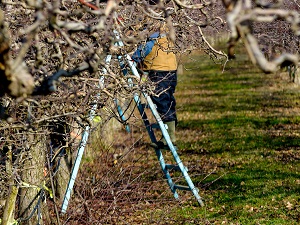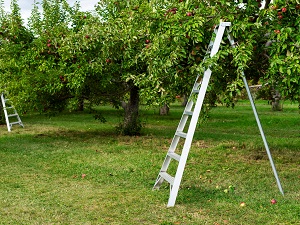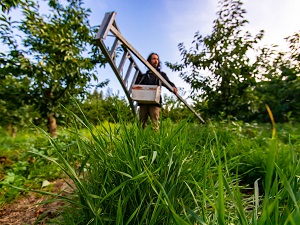All orchard workers and landscapers that may be using tripod orchard ladders must be trained to recognize hazards and report unsafe conditions to supervisors immediately.

What is a Tripod Orchard Ladder?
A tripod orchard ladder is a portable, self-supporting ladder used in orchards and landscape maintenance, for tasks such as pruning and fruit harvesting.
Proper Use and Design Limitations
A tripod orchard ladder should not be used as an all-purpose ladder. They are designed with a flared base and a tripod pole that provides support on soft, uneven ground.
OSHA Standard 1910.23(b)(8) The employer must ensure ladders are used only for the purposes for which they were designed.
Stability Features and Requirements
These unique ladders have no spreader bar or locking mechanisms to hold its front in place or to stabilize the ladder. Instead, for a tripod orchard ladder to function properly and remain stable, the ladder side rails and tripod pole must slightly penetrate the ground.
Tripod orchard ladders are for orchard or landscape use only and must never be used on hard ground.

Common Hazards
Like any other type of ladder, tripod orchard ladders can be dangerous if they are not used properly by workers.
Common hazards to watch out for when using a tripod orchard ladder include:
- Slips and falls caused by an unstable or defective ladder
- Ladder collapse due to overextension of the tripod pole
- Struck-by tree branches
- Sprains and strains from overreaching while on the ladder
- Overexertion injuries from moving, lifting, and carrying the ladder
- Struck-by a falling ladder
- Falls due to poor weather conditions
- Electrocutions when ladders are used too close to power lines
OSHA Standard 1910.23(c)(3) The employer must ensure that ladders are not loaded beyond the maximum intended load.

Inspect Ladder Before Use
Before use, workers should inspect the tripod orchard ladder they will be using to confirm that it is in good working condition. Check ladders for missing, loose, or sheared rivets, broken steps, and bent rails or tripod poles.
Ladders with defects or damage should be taken out of service. Place an “out of service” tag on a damaged ladder and separate it from the ladders that are safe to use.
After a ladder tips over, for any reason, it should be inspected before being placed back in service.
OSHA Standard 1910.23(b)(9) The employer must ensure ladders are inspected before initial use in each work shift, and more frequently as necessary, to identify any visible defects that could cause employee injury.
Ladder Lifting and Handling
Proper ladder lifting and handling techniques can protect workers from back injuries. To safely move a tripod orchard ladder place your arm through the ladder and balance the ladder on your shoulder. Carry ladders in a horizontal position with the top of the ladder facing forward, firmly securing the tripod pole to keep it from slipping out of the ladder notch.
Only carry one ladder at a time. Use caution when carrying a ladder near other workers or trees.

Safe Work Practices for Use
Prevent injuries when using tripod orchard ladders by utilizing safe work practices. Select and use ladders that are appropriate for the worker and the tree size.
Limit or reschedule work that requires the ladders on windy days or when there are unsafe weather conditions. Always keep ladders away from overhead power lines.
Use appropriate personal protective equipment when needed, like safety glasses or work gloves. Wear shoes with stiff soles and a substantial heel to prevent slipping while on the ladder.
Only one worker is allowed on the ladder at a time. Avoid walking under or near ladders when they are in use by another worker. Do not leave ladders standing open at the end of the workday.
OSHA Standard 1910.133(a) The employer shall ensure that each affected employee uses appropriate eye or face protection when exposed to eye or face hazards from flying particles.

Working Safely on a Tripod Orchard Ladder
When working on a ladder, falls are the most common hazard. It’s important that workers set-up the ladder properly, wear appropriate footwear and clothing, and work safely while on the ladder.
Place the ladder firmly in the ground to keep it from collapsing, slipping, moving, or falling. Make sure that the ladder is not positioned over a soft spot or hole. Ladders placed on sloped ground must have the tripod pole positioned uphill.
Maintain 3-points of contact while facing the ladder when climbing up and down.
OSHA Standard 1910.23(b)(11) The employer must ensure each employee faces the ladder when climbing up or down it.
Do not overreach while on the ladder, instead get down and move the ladder into a better position if needed.
Do not move from the ladder onto a tree branch. Do not stand on tree branches or use a tree branch for balance while on the ladder.
For orchard work, pick tree produce from the top to the bottom, do not overfill produce bags, and center the produce bag between the side rails of the ladder.

.jpeg)

